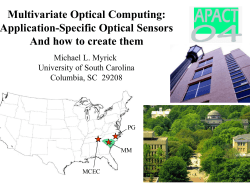
Course How to engineer practical optical communication Overview
Course How to engineer practical optical communication systems for long-haul, metro and access networks Overview The explosive growth of data, particularly internet traffic, has led to a dramatic increase in demand for transmission bandwidth. This requirement was initially addressed by widely employing single‐mode optical fibers to interconnect discrete network locations in a point‐to‐point fashion offering high capacity and long reach transmission capabilities. These links were terminated by SONET/SDH equipment forming ring and mesh network topologies. Such a scenario imposes unnecessarily high switching granularity, numerous optoelectronic conversions and complicated network management with poor scalability for data services, slow service turn up with high installation, operation and maintenance cost. With recent technology advances, Wavelength Division Multiplexing (WDM) is introduced to enhance further the available bandwidth while the WDM transport layer is migrating into elaborate networks with improved features, higher manageability, lower complexity and cost. This course gives an overview of the enabling technologies and provides an in depth understanding of the design criteria and methodologies used in the various segments of this type of networks including long‐haul, metro and access networks. It identifies the design challenges and solutions related with the technologies involved, and covers the required guidelines and engineering rules that enable design and implementation of current and future networks. It is important to note that studying the technologies used in this type of networks is necessary in understanding and performing not only the design and implementation, but also the operation and maintenance of optical networks. Objectives The course objective is to provide an overview of optical technologies and an understanding of the design, implementation, operation and maintenance issues associated with optical network solutions. The course will also cover guidelines and engineering rules that can be applied on existing and future optical network technologies. It is designed as an introductory/intermediate course on the topic. Who should attend This Short Course is addressed to: Managers/engineers/professional scientists working for operators and equipment manufacturers involved in network, system and subsystem design, operation and maintenance of telecommunications networks as well as business development and strategy planning Students and individuals who seek to advance their personal and/or professional status through learning Basic knowledge on communications networks. Prerequisites Duration Instructor 4‐day sessions Dr. I. Tomkos Course outline Lectures designed to build the theoretical knowledge on the topic cover 75% of the course duration. The rest 25% is devoted to acquiring hands‐on experience through laboratory exercises and demonstrations to be carried out in AIT’s optical communications lab. The practical part of the course includes introduction to the VPI Transmission Maker simulation tool and some simulation studies using the tool and laboratory demonstration of certain aspects of the physical optical layer. Optional homework assignments and quizzes will be available to interested groups and/or individuals. The course contents per day follow: Day 1: Introduction to optical networks Fiber transmission – Attenuation, chromatic dispersion, PMD and non‐ linearities Transmitters – Lasers and modulators Modulation Formats (e.g. NRZ, RZ, CS‐RZ, DPSK, Duobinary, QAM) and their performance Receivers – Fundamentals (Receiver design) and performance measures (bit error rate, power penalty, Q‐factor) Day 2: Optical amplifier types (e.g. EDFAs, SOAs, Raman, hybrids) and noise Multiplexing techniques including WDM, OTDM, CDMA WDM components (e.g. filters) and subsystems (e.g. wavelength converters, gates, regenerators) Network elements including Optical Add/Drop Multiplexers and Optical Cross‐ Connects and associated impairments Laboratory demonstrations of certain aspects of the physical optical layer Day 3: WDM system design, engineering rules Power and OSNR budgeting Dispersion and nonlinear penalties and dispersion maps Q‐factor budgeting WDM system operation and maintenance Ultra‐long‐haul backbone networks Introduction to the VPI Transmission Maker simulation tool Day 4: Metropolitan area optical networks Optical access networks Current deployment considerations Studies using the VPI Transmission Maker simulation tool Tuition Fee Program Registration Contact N/A Discount Policy Cancellation Policy www.ait.edu.gr/profPrograms/reg_form/admission_form.asp Catherine Cynthia Protonotarios Executive Training Manager Tel+30 2106682806, extn 5806 Fax+302106682844 execedu@ait.edu.gr
© Copyright 2025










![DigiLink Artel ships the DLC200 configured as follows: [DLC200]](http://cdn1.abcdocz.com/store/data/000321508_1-5ea6363a609c8f3a147a63246271aae9-250x500.png)










